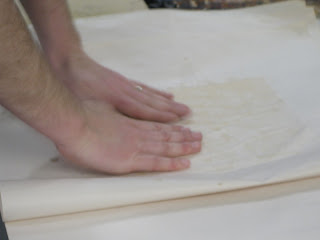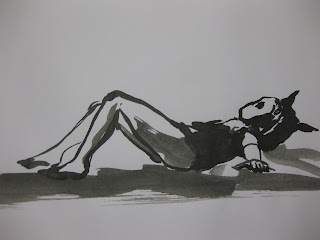Click here to see my draft proposal :-)
love and kisses, Julie.
Tuesday, August 28, 2012
The trials and tribulations of an art student :-)
Friday, August 17, 2012
Making mixed media art with Paul Murray
mixed media: in visual art, refers to an artwork in the making of which more than one medium has been employed. (http://en.wikipedia.org/wiki/Mixed_media)
On Friday we enjoyed a fabulous day of being taken through a process of building a mixed media piece of art with Paul Murray.
Paul provided us with an extensive materials list which included prepared boards, paints, pencils, images, papers, found objects, binding medium (or PVA glue) ....... plus our imaginations and an open mind!
There are many ways of making mixed media art. Thankfully for us newbies, Paul walked us through a process which familiarised us with the appropriate ways of layering materials, which glues to use when and what materials need to be sealed before adding paint or more layers and so on.
This is what we did:
1. Get a gesso'd board ready. We used 5mm mdf. This stage was basically collaging paper images. Select drawings, newspaper clippings, images from magazines, photos. Spend some time looking at them, arranging them, sketching ideas that are generated by the images, then when satisfied glue them down with binding medium or PVA glue. The binder is applied to the back of the images before they are stuck down - NOT the surface because the next stage required us to draw/paint on the collaged images.
 |
| white gessoed board with photos, ink paintings and newsprint added |
2. Draw over the images with ink, charcoal, pencil, conte or whatever drawing tools you wish. We were being as spontaneous as possible for this exercise, so drawings were random responses to whatever was inspired by the images we had collaged. After we were happy with the drawing we sealed the whole board with binder medium/PVA and let it all dry (or used a hair dryer to speed the process).
 |
| ink and charcoal over the images - note 'veiled' effect of ink over the images |
 |
| I glued wire mesh (hot melt glue gun), cardboard, lace and calico onto my work |
 |
| 'hue/saturation layer added |
 |
| 'fresco' layer added, 'curves' altered, some painting brush work applied |
 |
| final image |
 |
| detail |
 |
| detail |
It was a lot of work getting through these steps in one day, but thoroughly enjoyable and great to be adding new skills and understandings to our 'artistic' vocabulary.
Thursday, August 16, 2012
Intaglio Printing with Bernie part 2
This week we continued learning about intaglio printing with Bernie.
Requirements:
- bath of ferric chloride (corrosive salt)
- file
- burnishing/scraping tool
- protective gloves
- printing ink
- small rectangles of clean, firm card
- quarter sheets of yellow pages type paper
- tarlatan cloth
- spare clean rags
- plenty of clean newspaper
- water bath for the printing paper
- clean butchers paper
- etching paper (300gsm) torn to the required size (no pencil marks or scissors!)
- templates for the placement of the plate and paper
- a printing press!! (or steam roller)
- turpentine
Etching the copper plate
I forget to get a picture of this process!
Etching needs to be done in a dedicated space, with protective rubber gloves, a bucket of clean water and a timer.
The copper plate has four small 'feet' of blu tack placed on the printing side and it is then placed blu tacked side down into the shallow bath of ferric chloride. The time of the bath depends on the strength of the chloride and it is worth doing a test, covering parts of the plate with masking tape, then immersing it in the bath for periods of time (which you record!) and looking at the result, perhaps doing a test print before deciding on an immersion time for the plate.
We were re-using ferric chloride, so immersed our plates for about 45 minutes.
We took the plates out of the ferric chloride and immersed them into a bucket of clean water, then dried them off.
We then took the plates to a well ventilated area and cleaned the bitumen off with turpentine. The cleaned plates were then ready to be prepared for printing.
Preparing the copper plate edges for printing
The edges of the copper plate need to filed, scraped and burnished so that the print doesn't have an unintended border. The plate will need to be filed quite firmly so use a brace board or similar to prevent it from slipping.
The edge needs to be filed to 45º. File until you can see about 1mm of clean copper.
When the edges are ready, give the plate a polish to remove fingerprints or other marks.
The plate is now prepared for the ink.
Preparing the area being used for printing
We used oil based ink, but water based acrylic inks are also available. It is essential to wear protective gloves for this process.
It is also worthwhile to have a designated 'dirty' area for inking the plate and a 'clean' area for handling paper and printing.
Cover the 'dirty' area with clean newspaper.
Prepare the water bath at the 'clean' area and have sheets of butchers paper next to the water bath ready to blot the printing paper prior to printing.
Have clean butchers paper for the paper to lie on once it is blotted and you are preparing the press.
Inking the plate
Squeeze out a small amount of ink and use a piece of card to scrape it firmly across the plate. First one way...
then the other.
When the ink has been applied rub the plate with a piece of tarlatan cloth, which pushes the ink into the etched lines. It also removes excess ink from the plate.
Use a piece of rag to remove any ink from the bevelled edges.
When the plate is clean give it a polish with a piece of the cut up yellow pages. Great re-cycling!
Give the back of the plate a wipe to remove ink, but don't overdo it as you will get the printing surface dirty again. Now put the plate in the clean area, near the printing press while preparing the paper.
Only one print is made at a time.
After each print the plate is re-inked and the plastic protector sheet on the press cleaned to remove any ink left from the back of the copper plate.
Printing
From this point on it is essential to have clean hands.
Place pieces of printing paper, torn to the correct size, in the clean water bath.
Make sure that each piece of paper is properly wet before adding another piece.
The paper is put aside on clean butchers paper while the press is prepared.
Bernie had already done a test print to check that the pressure on the print rollers was going to produce an even print on our paper.
 |
| Bernie pointing out where the press roller needs more pressure to achieve an even print |
Ensure that the surface of the plastic is clean. Clean rags should be nearby to make sure of this.
Then place the copper plate on the template (which is under the plastic!) - print side up (don't laugh, I nearly put mine print side down)
Carefully lay the paper in the place marked on the template, ensuring it is oriented the right way (particularly important if you have made the lower border wider than the sides and top borders).
Lay the two mats on the paper. The woven, thinner one on the paper, the thicker, felt one on top.
Time to turn the wheel and print!
Remove the blankets and look at your print. If your fingers are not really clean you can make a little holder as shown here.
The prints should be dried between sheets of clean butchers paper, with weights on top, to ensure that the paper dries flat, rather than buckling as it dries.
Some of our prints.
Tuesday, August 14, 2012
Saturday, August 11, 2012
How to make a glueless concertina book
On Thursday, while we waited for the bitumen paint on our copper etching plates to dry Bernie taught us how to make a concertina book. He had several samples of small artist's books, many of which were inspiringly interesting, beautiful or intriguing. There are many ways to make your own books, here is one way of quickly making a good looking and useful book.
You need:
 |
| here's my sample book |
How to make a glueless concertina book :-)
You need:
- strips of paper 11cm wide and about 60cm long. We used two strips so we did in fact need a little glue (glue stick type, it doesn't wet the paper and make it warp) to join our two strips
- 2 pieces of 11cm x 11cm card
- paper to cover the board covers (we used magazine pictures because they were convenient and quick to use, but obviously one's own drawings/prints/artwork would be better
- bone paper creaser and folder (you can see one of these in the second picture down from here
- metal ruler
- craft knife
Then..
This diagram shows you how to fold the pieces of paper, using 'mountain' and 'valley' folds.
Measure the 11cm squares and score along each one using the bone tool so that the concertina folds are crisp.
 |
| like this |
If you are going to join two pieces of paper, trim the excess off one end (visible in the above pic as a 3 cm end piece) to 1cm long then glue the 1cm piece to the back of the other folded piece of paper (or card) to form a 'valley' fold.
Next make the covers:
You will need the 11cm square pieces of card.
Then cut two cover papers, one with 2cm tabs on the sides and one with 2cm tabs on the top and bottom, as can be seen in this picture.
Now you fold the cover papers around the card, then slide the whole cover over one end of the concertina book.
Repeat this process for the other cover, your book should look like this.
Then make a 'spine' for the book, as you can see in the pic below. This is a piece of paper matching the covers (or contrasting if you prefer!) which is 11cm tall and about 6-7cm wide. Fold it in half and slip it into the covers.
 |
| How fabulous is this? |
 |
| I added a sliding panel to the front cover of my book |
Then fill your book with something fantastic, interesting, subversive, wild, humorous.....let the imagination run wild!!
I made this book as a sample and have used other people's art work for the covers so it is inappropriate for me to put my own stuff in it but I can't wait to make my own art filled book.
Great process, fab books! Thanks Bernie.
Subscribe to:
Posts (Atom)







































